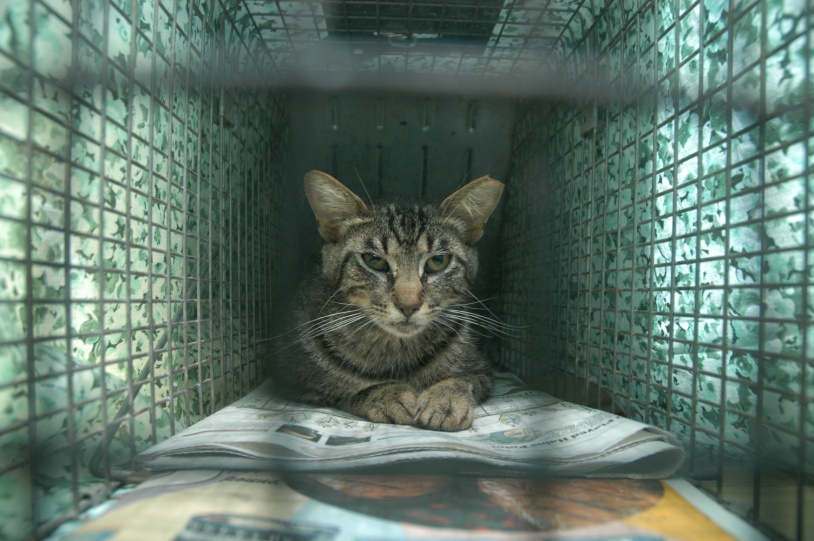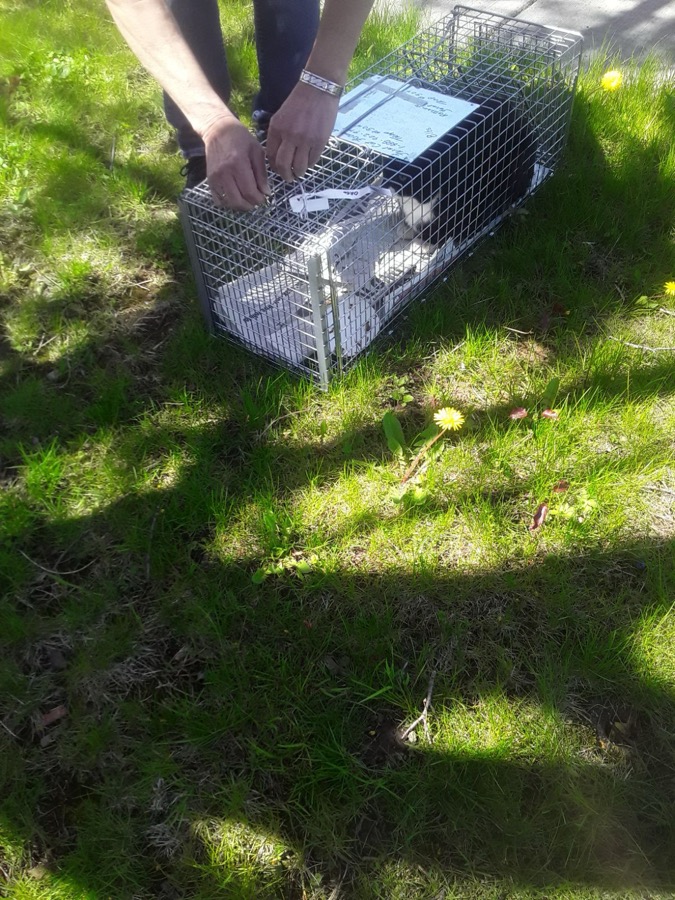Humane Trapping – Trapping Basics


Just follow these steps to help make your Trap-Neuter-Vaccinate-Return efforts successful. At the end of these guidelines there are helpful links to comprehensive TNVR handbooks and how-to videos for the humane trapping of feral cats.
WITHHOLD FOOD
You must withhold all food 24 hours before trapping. This will ensure that the cats are hungry enough to enter the trap. While this may be hard, particularly if the cats appear hungry, remember you are doing what is best for them. Continue to provide the cats with clean, fresh drinking water. Remind other caregivers and neighbors to withhold food as well.
SET-UP AND PREPARE FOR TRAPPING
When it’s possible to do, mass trapping is preferable to a “one-cat-at-a-time”. Mass trapping refers to the TNVR of an entire colony at once.
Trapping will also go more smoothly if you don’t disrupt the cats’ feeding area.
Do all of your set up and preparation away from the colony site because feral cats are generally fearful of people. Prepare the traps near your vehicle or away from the trapping site.
Alert neighbors to your Trap-Neuter-Vaccinate-Return efforts. If you are trapping in residential areas post signs advising when and where you will be trapping in their neighborhood.
TAG THE TRAP
Tag the traps with a description of the location so that you can return the cats to the exact location where you trapped them.
If you open the rear door, be sure to relock it before trapping. If your trap does not have a rear door, you can secure the front door open with a twist tie while you work and then remove it for trapping.
BAIT THE TRAP
Ensure the trip plate is functioning properly.
Place approximately one tablespoon of bait (tuna, sardines, or other strong smelling food—usually the ones in oil work best) at the very back of the trap on the far right hand side so the cat will step on the trigger plate while attempting to reach the food.
NOTE: If the cat has been without food and you are trapping 24 hours before surgery use two tablespoons of bait.
You may choose to put the food on a quarter piece of paper plate or a small piece of cardboard. Never use a can or dish or any sharp items as these could injure the cat once trapped.
Drizzle some juice from the bait in a zigzag pattern along the trap floor toward the entrance. You should also place a tiny bit of food (1/4 teaspoon) just inside the entrance of the trap to encourage the cat to walk in.
Do not use too much food at the entrance of the trap because the cat may be satisfied before making it to the trip plate. Also, cats should have an empty stomach for at least 12 hours before surgery.
Trapping Tip: If a cat/s won’t go into the trap, you may want to try feeding them in unset traps for several days before trapping. Feed the cats in the same place and time as always. Wire the doors to the traps open and place the food inside. Once the cats see other cats eating inside the traps they will try it themselves. Once they become accustomed to the traps they will be easier to trap.
SET THE TRAPS
Place a trap on the ground and make certain it is stable and will not rock or tip—cats will not enter an unstable trap. Do not place the trap on a hillside or incline.
If you are using multiple traps, stagger them and have them facing different directions. Try to place the traps where they will attract a cat and be camouflaged, for example, near a bush.
Move quietly and slowly so your movements will not frighten cats away.
On your already prepared trap labels, fill in the exact location where you are setting the trap. This will make return much easier!
Leave the area quietly. The cats are unlikely to enter the traps if you are standing nearby. You may want to go sit in your car or take a walk for a while. If you are trapping in your yard you can go inside.
KEEP TRACK OF THE TRAPS AT ALL TIMES
Traps should never be left unattended. Check the traps frequently from a distance. Choose a location to park your car and wait where you are far enough away to give the cats a sense of safety, but close enough so that you can see them.
If you are trapping alone don’t put out more traps than you can keep an eye on. In larger colonies there may be multiple trapping locations. It is important not to leave any traps unsupervised, so consider bringing multiple trappers to help
There are several reasons to make sure you always have an eye on the traps:
- Leaving a cat uncovered in a trap for too long will increase the cat’s stress and could lead to injury since they thrash against the cage. You may want to place a sheet over just the back part of the trap—not the front—before you place the trap so you can easily cover the entire thing after the cat is caught. This could also encourage the cat to go inside the trap since it appears to be a covered, safe place. (NOTE: Do not do this if it is windy outside. If the cats catch signs of movement they will not enter the trap.)
- When in a trap, the cat is exposed—and could be injured by other animals or a malicious person.
- Traps may be stolen, damaged, or sprung, or someone who does not understand your intentions may release a trapped cat. To be safe, take an exact count of your traps at the beginning and end of your trapping day.
Be prepared for the fact that you may trap cats that are already eartipped. If you do, it is sometimes best to hold that cat in the covered trap until the cats you are aiming for have been trapped.
Trapping a feral cat may take some time, be patient. It may take the cat a few minutes to go into the trap, so make sure the trap is sprung, and the cat securely trapped, before you approach the trap.
AFTER THE CAT HAS BEEN TRAPPED, SPRING INTO ACTION
Cover the entire trap with a large towel (beach size), blanket or sheet before moving it. Covering the traps will help to keep the cats calm. Move trapped cats away to a quiet, safe area to avoid scaring any remaining, untrapped cats.
TRAPPING IS TOUGH LOVE! It is normal for cats to thrash around inside the trap. You may be tempted to release a thrashing cat because you fear that she will hurt herself, but cats calm down once the trap is covered. Remember, you are doing this for her benefit. If she is released, you may not be able to trap her again and she will continue to breed. Also, most injuries from traps are very minor, such as a bruised or bloody nose or a scratched paw pad.
You should never open the trap or try to touch a conscious or semi-conscious feral cat. Behave appropriately around trapped cats by being calm, quiet, and not touching them, even if they appear friendly under normal circumstances.
When an entire colony is being trapped from the same area, it does not make sense to take each cat from the location directly after the trap is sprung. This could disturb the area and scare the other cats away. Instead, when you are setting the traps out you can partially cover them to help calm the cats once they are trapped. Since they will at least have part of the trap that is covered, they can feel safe and you can keep the trap where it is. This helps reduce stress to the trapped cat and reduce the odds of other cats being frightened away.
Keep in mind that these are guidelines and some situations will call for you to deviate from them. For example, if a cat is severely thrashing around you may need to go ahead and cover the trap and remove it from the area, or if you are trapping in cold weather, cats should be covered and moved to a warm location (like your car) as soon as they are trapped.
During a quiet moment when no other cats are investigating the set traps, or if the trapped cats are making noise and deterring other cats from approaching the traps, remove the full traps and put them in the holding vehicle. Rebait any traps that have had the bait eaten but have not sprung.
HARD-TO-TRAP CATS
Cats can become trap-shy—frightened to go near or enter a trap, or trap-savvy—mastered the art of removing food without triggering the trap. Don’t be discouraged. There are several unique but straightforward techniques to humanely trap hard-to-trap-cats. Visit our Tips for Hard-to-Trap Cats page for more information.
COUNT YOUR TRAPS AGAIN
Count your traps when you are finished to ensure you didn’t leave any traps behind.
If you have borrowed your trap from Feral Cat Focus you are responsible for the traps.
TAKE CATS TO A VETERINARIAN OR A SPAY/NEUTER CLINIC
You should have already made appointments for sterilization and vaccination before beginning to trap. Your trapping should coincide with the clinic’s ability to neuter right away—or the very next morning, so the cats don’t remain in their traps for long.
IMPORTANT: It is possible for a cat to die from hypothermia or heat stroke when confined in a trap outside. A simple guideline—if it is too hot or cold outside for you, then it is too hot or cold for the cats.
If your appointments are not the same day as the trapping, keep the cats indoors in their covered traps and make sure they are dry, in a temperature-controlled environment, and away from dangers such as toxic fumes, other animals, or people.
TRANSPORT YOUR CATS
Check to make sure the trap is locked. Always check the front and back of trap to make sure it is locked and the cat cannot get out. You never want to lose a cat in transport.
Never transport cats in an open-bed truck or closed, unventilated car trunk. These are not safe situations for cats and are and extremely terrifying to cats.
Keep the trap and cat covered at all times. Placing a trap cover, blanket, or an old towel over the trap will allow the cat to remain quiet and feel more comfortable.
Protect your car’s interior from spraying, urinating or defecating.Line it with plastic, then an old blanket and use newspaper on top of it. Puppy pee pads make great protectors.
SAFETY NOTE-PLASTIC LINERS: When preparing your vehicle to transport cats be careful if using plastic to line the floor. Plastic must be covered with material and or newspapers. Make sure the plastic is not wrapped around the trap in any way! Plastic can cause suffocation and/or heat stroke for a cat when wrapped around a trap. Never use plastic between or over traps because of the risk of suffocation and/or heat stroke.
Safety of the cat is most important. Stacking of traps is not advisable. It’s best to transport in a single layer of traps (get a friend to help you transport!).
IF TRAPS MUST BE STACKED INSIDE A VEHICLE, be sure to secure them with bungee cords or other restraints so they don’t tip over and potentially open and injure or release the cat. If an unsecured trap tips sideways or upside down, it can open and release the cat. If it seems precarious, it won’t work. Don’t take the risk!! Always use a thick layer of newspaper between the traps, to avoid defecation on another cat in a trap. Place puppy pads or newspaper between the stacked traps.
